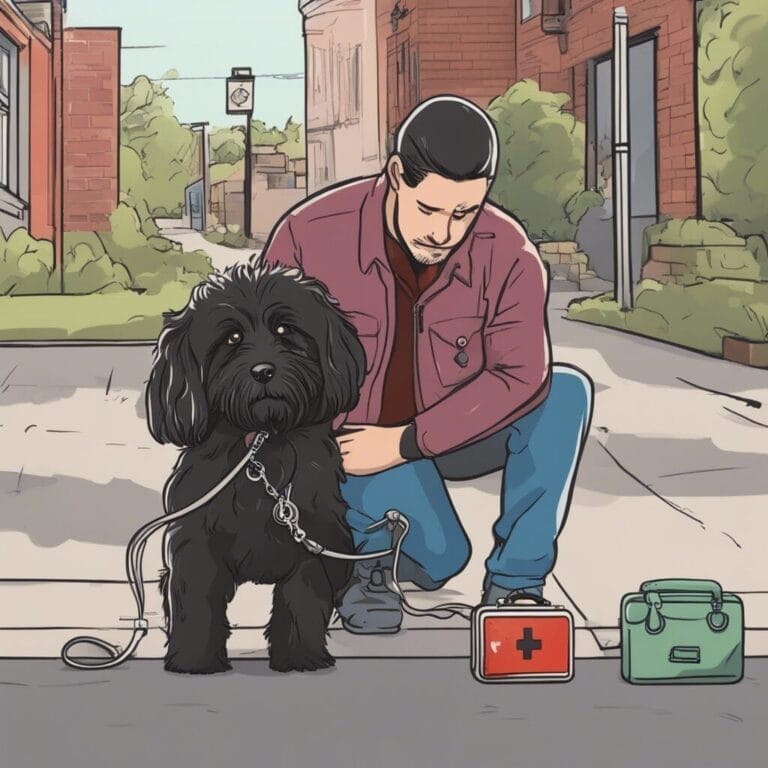
Are you worried about your beloved dog’s limping? Wondering why it’s happening? Understanding the causes of your dog’s limping is crucial for their well-being.
In this article, we’ll shed light on why your dog may be limping and why it’s important to address it promptly. By taking action, you can alleviate their pain and prevent further complications. Early detection and treatment can also prevent long-term issues.
Join us as we explore the common causes of limping in dogs and provide valuable insights on how to help your furry friend.
Key Takeaways
- Limping in dogs is often a sign of pain or discomfort and should not be ignored.
- Limping can be an early indication of injuries or underlying illnesses, so early detection and treatment are important.
- Untreated causes of limping, such as joint issues or musculoskeletal problems, can lead to long-term complications.
- Common causes of limping in dogs include injuries, arthritis, infections, muscle strains, bone conditions, and paw injuries.
Importance of Addressing Your Dog’s Limping
Addressing your dog’s limping is crucial for ensuring their health and well-being. When your furry friend is limping, it’s important to take action.
Limping is often a sign of pain or discomfort, and ignoring it can lead to further complications and affect their quality of life. By addressing the limping early on, you can detect and treat any underlying injuries or illnesses. This can prevent the conditions from worsening and save your dog from unnecessary suffering.
Additionally, taking action early can help prevent long-term complications, especially in cases of joint issues or musculoskeletal problems. By seeking veterinary care and following their recommended treatment plan, you’re serving your dog’s need for comfort, mobility, and a happy and healthy life.
Pain and Discomfort Associated With Limping
Experiencing pain and discomfort, limping can be distressing for your dog. It’s important to understand the implications of your dog’s limping and the pain and discomfort associated with it.
Here are some key points to consider:
- Limping is often an indication that your dog is experiencing pain or discomfort. Ignoring the limping can lead to further complications and affect their quality of life.
- Early detection of injuries or illnesses is crucial. Limping can be an early sign of injuries or underlying illnesses. Identifying and addressing these issues promptly can prevent them from worsening and potentially save your dog from suffering.
- Limping can also lead to long-term complications. Some causes, such as joint issues or musculoskeletal problems, can progress if left untreated. Taking action early on can minimize the risk of long-term complications and improve your dog’s overall mobility.
- Proper diagnosis and treatment are necessary. Consulting a veterinarian if your dog is limping persistently or showing signs of pain is crucial. They can provide a proper diagnosis and recommend the appropriate treatment plan to alleviate your dog’s discomfort and promote their recovery and well-being.
Early Detection of Injuries or Illnesses Through Limping
How can you identify injuries or illnesses early through your dog’s limping?
Paying attention to your dog’s limping can help you detect any underlying injuries or illnesses early on. Persistent limping or limping accompanied by other signs of pain, such as whining or changes in behavior, shouldn’t be ignored. It’s important to consult a veterinarian for a proper diagnosis and treatment plan.
Accidents, falls, arthritis, infections, muscle strains, and bone conditions are common causes of limping in dogs. If your dog is limping, prompt veterinary attention can prevent further complications and promote their recovery and well-being.
Preventing Long-Term Complications From Limping
To prevent long-term complications from your dog’s limping, you should take proactive measures to address the underlying causes and seek appropriate veterinary care. Here are some steps you can take to help your dog recover and minimize the risk of long-term issues:
- Consult a veterinarian: It’s important to have your dog examined by a professional to determine the cause of the limping and receive proper treatment.
- Follow treatment recommendations: Once a diagnosis is made, follow the veterinarian’s advice regarding medication, physical therapy, or any other recommended treatments.
- Provide a comfortable environment: Ensure your dog has a soft and supportive bed to rest on, and consider using ramps or stairs to help them navigate elevated surfaces.
- Encourage gentle exercise: Controlled and supervised exercise can help improve your dog’s mobility and prevent muscle atrophy.
Taking these proactive measures can make a significant difference in your dog’s recovery and overall well-being. By addressing the underlying causes of limping and seeking appropriate care, you can help your furry friend live a happy and healthy life.
Common Causes of Limping in Dogs
If your dog is limping, it can be caused by a variety of factors, including injuries, arthritis, infections, muscle strains or ruptures, bone conditions, or foreign objects or injuries to the paw. It is important to understand the common causes of limping in dogs to address the issue effectively. Here are some common causes of limping:
| Causes | Description | Treatment |
|---|---|---|
| Injuries | Accidents, falls, or trauma can result in limping. Sprains, fractures, or dislocations are common injuries that require immediate veterinary attention. | Veterinary evaluation and treatment |
| Arthritis | Arthritis is a degenerative joint disease that causes pain, inflammation, and stiffness. It can be a common cause of limping, especially in older dogs. | Medications, joint supplements, therapy |
| Infections | Infections, such as Lyme disease or bacterial infections, can cause limb pain and limping. Proper diagnosis and treatment are necessary to resolve the infection. | Antibiotics, anti-inflammatory drugs |
| Muscle strains/ruptures | Overexertion, sudden movements, or excessive exercise can lead to muscle strains or ruptures. Rest and gradual rehabilitation may be needed for recovery. | Rest, pain management, physical therapy |
| Bone conditions | Certain bone conditions, including bone tumors or developmental abnormalities, can result in limping. Timely diagnosis and intervention are essential. | Diagnostic tests, surgery, medication |
| Foreign objects/injuries to the paw | Splinters, thorns, cuts, or foreign objects lodged in the paw can cause pain and limping. Inspecting the paws regularly and removing any foreign objects promptly can prevent limping. | Paw inspection, removal of foreign objects |
If your dog is limping persistently or if you notice any signs of pain, it is important to consult a veterinarian. They can provide a proper diagnosis and recommend the appropriate treatment plan to alleviate your dog’s discomfort and promote their recovery and well-being.
Injuries as a Cause of Limping
If your dog is limping, it’s important to consider injuries as a potential cause. Limping can often be a result of accidents, falls, or trauma that your dog may have experienced.
Here are four common injuries that could be causing your dog’s limping:
- Sprains and strains: Overstretching or tearing of ligaments or tendons can occur during abrupt movements or excessive exercise.
- Fractures: Direct impact or excessive force can cause bone fractures.
- Dislocations: A sudden forceful movement can dislocate a joint, causing pain and limping.
- Muscle strains or ruptures: Overexertion, sudden movements, or excessive exercise can lead to muscle strains or ruptures.
It is important to seek veterinary advice if your dog is limping persistently or showing signs of pain. A proper diagnosis and appropriate treatment plan can help alleviate your dog’s discomfort and promote their recovery and well-being.
Arthritis as a Cause of Limping
Arthritis can be a common cause of limping in your dog, so it’s important to be aware of the signs and seek veterinary care. Arthritis is a degenerative joint disease that causes pain, inflammation, and stiffness. It can affect dogs of all ages and breeds, but it is more common in older dogs. To help you understand the impact of arthritis on your dog’s mobility, here is a table outlining the signs and symptoms:
| Signs and Symptoms of Arthritis |
|---|
| Limping or favoring a limb |
| Stiffness or difficulty getting up or lying down |
| Reluctance to jump or climb stairs |
| Lameness in one or more legs |
| Swelling or heat in the affected joints |
If you notice any of these signs in your dog, it is important to consult a veterinarian. They can provide a proper diagnosis and recommend a treatment plan to alleviate your dog’s discomfort. Treatment options may include pain medication, joint supplements, weight management, and physical therapy exercises. With proper care and management, your dog can enjoy a more comfortable and active life.
Muscle Strains and Ruptures as a Cause of Limping
Sometimes, muscle strains or ruptures can cause your dog to limp. It can be distressing to see your furry companion in pain, but understanding the common causes of muscle strains and ruptures can help you provide the necessary care. Here are some key points to keep in mind:
- Overexertion or sudden movements: Dogs can strain their muscles or even experience muscle ruptures from activities like running, jumping, or playing too vigorously.
- Excessive exercise: Pushing your dog to exercise beyond their limits can lead to muscle strains or ruptures.
- Age and physical condition: Older dogs or those with pre-existing muscle weakness may be more prone to muscle injuries.
- Rest and gradual rehabilitation: Treatment for muscle strains or ruptures usually involves rest, limiting physical activity, and gradually reintroducing exercise under the guidance of a veterinarian.
Conclusion
In conclusion, addressing your dog’s limping is crucial for their well-being and quality of life.
By recognizing the signs and seeking prompt veterinary care, you can alleviate their pain and discomfort.
Early detection of underlying injuries or illnesses can prevent further complications and long-term mobility issues.
Remember, your dog relies on you to provide the care they need, so don’t hesitate to take action and ensure their health and happiness.
- About the Author
- Latest Posts

Sara is a passionate writer and an avid lover of Havanese dogs. With several years of experience in dog training, breeding, and care, she has developed a deep understanding and admiration for the Havanese breed. Sara’s mission is to provide valuable insights, resources, and tips to help Havanese dog owners provide the best possible care and nurturing for their beloved pets.








